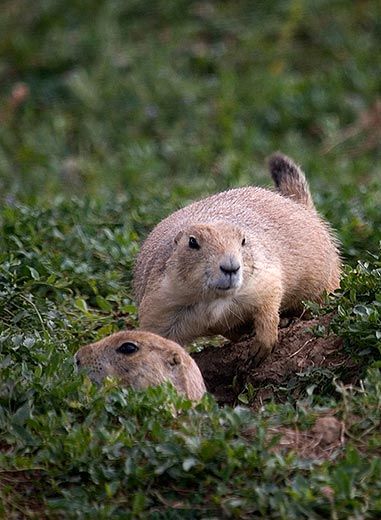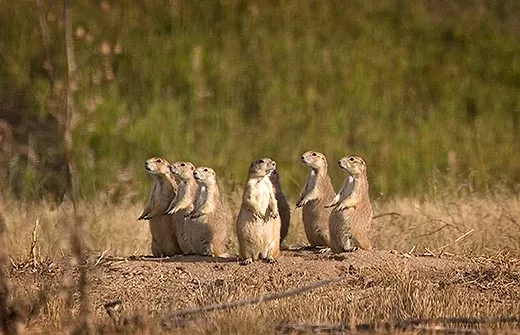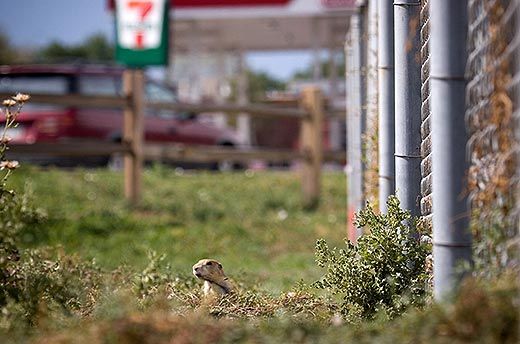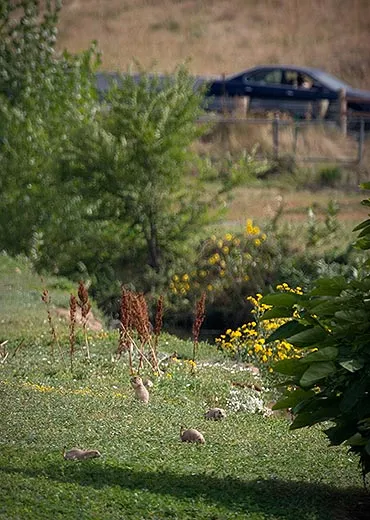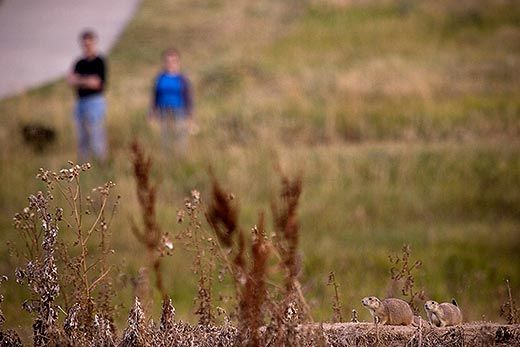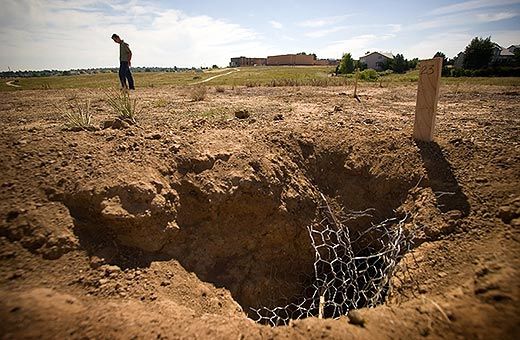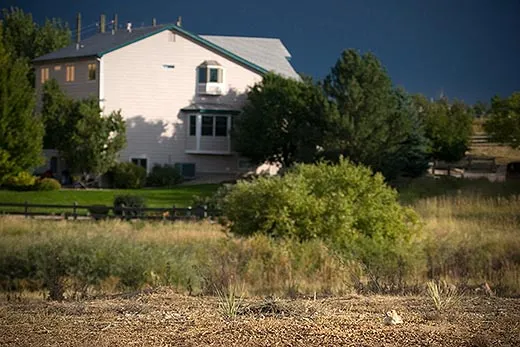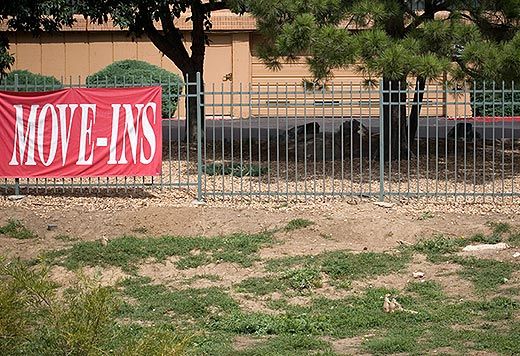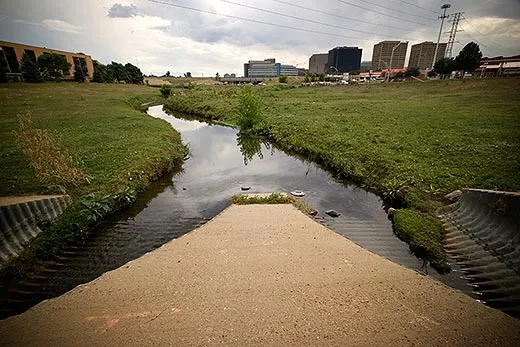Denver’s Street-Smart Prairie Dogs
Researchers explore why members of one species are thriving in urban areas while rural populations dwindle
/https://tf-cmsv2-smithsonianmag-media.s3.amazonaws.com/filer/family-of-black-tailed-prairie-dogs-631.jpg)
Prairie dogs start barking bloody murder and scramble for their burrows as a hawk glides fast and low over the colony. The emergency broadcast gives the rotund fur balls ample warning. For the raptor, it’s wishful thinking.
“Whoa! Now would you look at that,” says Kevin Crooks, a biologist at Colorado State University. Crooks, tall and wiry with an easy grin, points to the north. A second raptor sweeps lazy circles under the morning sun, and a third perches atop a fake tree trunk that was erected here to attract prairie-dog-eating birds.
We’re standing on a narrow strip of prairie running through the community of Highlands Ranch just south of Denver. Here, tucked among a high school football field, a paved running trail and rows of tidy, two-story cookie-cutter houses, lives a colony of about 30 black-tailed prairie dogs.
Danger averted, the prairie dogs once again peek from their burrows and start scampering about, touching noses in greeting and browsing on grasses and flowers. But something’s awry. Wooden stakes mark several mounds, and many of the burrow openings are masked by chicken wire. The stakes are numbered, and by all appearances, so are the prairie dogs’ days in this section of Highlands Ranch.
The stakes, it turns out, are part of a passive relocation project run by the Douglas County Citizens for Wildlife, and an attempt to save the colony. These prairie dogs verge on taking up residence in people’s yards, and the hope is that by blocking the burrows the animals will move away from houses and into undeveloped land where they can continue to go about their prairie dog lives.
If the critters fail to get the message, Highlands Ranch will resort to lethal control, which involves either fumigating the colonies or capturing and sending prairie dogs to raptor and black-footed ferret recovery programs, where they will be used as food. This neighborhood illustrates the challenge of trying to balance human communities with prairie dog ones, and it’s a coexistence that has pitted many Westerners against the diggers, and each other, for decades.
Black-tailed prairie dogs are vanishing from the West. In the past 200 years, their numbers have dwindled to just 2 percent of their estimated historic population because of introduced plague, recreational shooting and development. Colonies “are just blinking out because of development,” says Crooks. “There’s no other word for it. Prairie dogs have been exterminated over vast ranges of their habitat.” The black-tailed prairie dog is currently being considered for protection under the federal Endangered Species Act. It would be the third of five prairie dog species in the United States, after the Mexican and Utah prairie dogs, to be listed.
When one thinks of potential endangered species, it’s not common to look in the backyard, never mind territories that include a lot of traffic, buildings and city slickers. But black-tailed prairie dogs are bucking trends and taking advantage of urban green spaces—rather successfully. In places like Denver and Boulder, it’s nearly impossible to walk, bicycle or drive without tripping over or flattening one of these vocal critters.
This unusual existence brings with it an unusual ecology, which until now has remained largely mysterious. Previous research on prairie dogs stuck mostly to rural colonies, but thanks to the curiosity of one of Crooks’ former graduate students, Seth Magle, researchers are learning about the urban variety. “It’s very important for a number of reasons,” says Magle. “Urban areas are expanding. Protected areas are not.”
Magle started studying the secret lives of urban prairie dogs in 2002. He mapped their communities in Denver and found unexpected behaviors. Perhaps most startling of all was the robustness of this wildlife in a limited environment. Magle discovered that city prairie dogs lived in communities on average five times more crowded than rural colonies. Contrary to the expectation that confined and rapidly growing wildlife populations would crash because of population pressures like disease or competition for food, Magle found that prairie dogs seemed to get along pretty well in tight quarters.
Part of the reason they are thriving is that, in a city, they can spend more time chowing down and less time watching for predators. Urban prairie dogs deal with fewer coyotes and hawks than their rural counterparts, Magle said. They are generalists, munching away on whatever plants grow around their colony. And Magle observed that the city prairie dogs have some street-smarts. They climb shrubs and small trees to grub on leaves, and even swim—behaviors that were previously unknown for black-tailed prairie dogs.
Magle wondered whether day-to-day interactions with humans might make prairie dogs take kindly to people. He tried, a lot, to see if they’d get used to him. The typical response of a prairie dog colony to a suspicious stranger is for a few sentinels to send out a series of alarm barks, signaling the others to dive for cover. Instead of getting comfortable with Magle, or anyone else helping with the study, the prairie dogs skipped the barking and went straight to the run-for-cover phase. Not even bribery seems to work.
Magle recalls one woman who repeatedly stopped near the same colony at the same time of day and tossed a bag of mixed salad out her car window. “I thought that was such a strange human behavior,” says Magle. Sure, the prairie dogs weren’t ones to turn down a free meal, and they would eventually eat the greens, but they never came to anticipate her arrival or hang out when she was around, he says. “They’re not like squirrels.”
These interactions highlight the conflicted nature of the human-prairie dog relationship. People seem to think of prairie dogs as either a beloved example of backyard nature or a plague-ridden, land-destroying blight. Prairie dogs have earned the unsavory reputation from their tendency to chew down grass and create dusty, pock-marked landscapes in pastures, cropland and backyards. Prairie dog colonies do sometimes suffer plague outbreaks, and fears of the illness stem from the potential for plague-infected fleas to hitch a ride on prairie dogs and jump to people. Many mammals, though, from mouse to housecat, could pass on the fleas, and according to the Centers for Disease Control and Prevention, only about 10 to 20 people a year nationwide get the plague, and fatalities are rare.
For those worried that contact with urban prairie dogs will transmit plague, Magle has some encouraging news. In five years of field research, not once did he encounter a plague outbreak in his prairie dogs. The urban colonies' isolation helps prevent the spread of the disease because they tend not to catch it from their rural cousins or even other urban colonies, says Magle. That’s not to suggest anyone start cuddling with the animals anytime soon.
Regardless, mention prairie dogs to a Westerner, and you’ll either spark a debate about which gun is best to shoot them with or incite pleas to protect them. Throughout his study, Magle fended off people who thought he was killing the prairie dogs and those who were upset because he wasn’t.
Magle’s research inspired conservation social scientists Tara Teel and Brad Milley, both at Colorado State University at the time, to survey people’s opinions about living with prairie dogs. Almost 20 percent of people surveyed in the area south of Denver just plain wanted prairie dogs dead. About 40 percent wanted them protected, and another 40 percent were okay with lethal control if the prairie dogs raised the risk of plague or property damage. “People’s reactions to prairie dog management are often values-based and emotional,” says Teel. “But we need to better understand what the public thinks about these issues and how to anticipate and address conflict.”
Listing black-tailed prairie dogs under the Endangered Species Act would create unprecedented challenges. Imagine being told you can’t develop an empty inner-city lot because prairie dogs live there, or being a wildlife manager tasked with keeping an eye on daily interactions between wildlife and people in a metropolitan area like Denver, or worrying about what’ll happen if you run over a prairie dog on the way to the grocery store. Things like the Safe Harbor Agreement—an arrangement with the federal government that rewards private land owners for fostering recovery of endangered species on their land—could help, but wouldn’t be a complete answer. People need to consider the difficulties that would come with listing, says Magle. “It would be different from the usual thinking of setting up nature preserves.”
But Magle tries to look at the positive side. Urban prairie dogs offer residents nature education within city limits. If protected, prairie dogs could help preserve pockets of prairie even as sprawl overtakes many areas in the West. And these islands of habitat could act as refuges from the plague, keeping some prairie dogs alive if an outbreak strikes rural populations.
Crooks and I walk through another colony in south Denver. This one is bordered by Interstate 225, a strip of gas stations and an apartment complex advertising immediate move-ins. The prairie dogs live in a ditch full of invasive weeds. But this colony is being protected from future development as a natural area managed by the Denver Water Board. With each step we take, a prairie dog announces our presence with its metronomic yap and at least a dozen others send suspicious sidelong stares from the safety of their burrows. I feel silly, like I need to apologize for interrupting their day. “It’s kind of crazy, huh?” says Crooks. “It’s also kind of encouraging that prairie dogs can exist in these highly urbanized areas. We have to savor small victories.”
